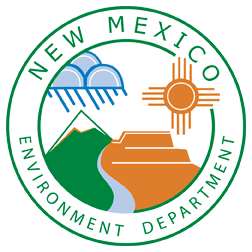The blue skies and scenic vistas of New Mexico are considered to be some of the most beautiful in the United States, but air pollution can threaten those views. Human-caused pollution of varied concentrations and sizes in the atmosphere can, along with natural events like dust storms and wildfires, impair or reduce visibility. Widespread visibility impairment caused by man-made pollutants over a broad geographic area is known as regional haze.
Recent Regional Haze Activity
On September 11, 2024, NMED petitioned the Environmental Improvement Board to adopt New Mexico’s proposed Regional Haze State Implementation Plan Revision for the Second Implementation Period and new companion rule 20.2.68 NMAC – Regional Haze Requirements. All documents related to the matter, designated EIB 24-49 (R), are available on NMED’s Docketed Matters web page at https://www.env.nm.gov/opf/docketed-matters/. To locate the documents, click on “Environmental Improvement Board” to display the drop-down list of matters before the Board, then click on “EIB 24-49: In the Matter of Regional Haze State Implementation Plan Revision for the Second Planning Period and Proposed Companion Rule 20.2.68 NMAC – Regional Haze Requirements” to display the drop-down list of documents filed in conjunction with the matter. Direct links to the proposed plan and companion rule are provided below.
- Revised Proposed Regional Haze State Implementation Plan Revision
- Revised Proposed Rule 20.2.68 NMAC – Regional Haze Requirements
On April 28-30, 2025, the Environmental Improvement Board held a public hearing on New Mexico’s proposed Regional Haze State Implementation Plan Revision and new companion rule 20.2.68 NMAC – Regional Haze Requirements. Numerous witnesses testified during the hearing on behalf of NMED, El Paso Natural Gas Company, Enterprise Field Services, and Targa Resources, and members of the public had multiple opportunities to provide public comment. Links to recordings of the proceedings are provided below.
- Environmental Improvement Board Public Hearing April 28, 2025 EIB24-49(R)
- Environmental Improvement Board Public Hearing April 29, 2025 EIB24-49(R)
- Environmental Improvement Board Public Hearing April 30, 2025 EIB24-49(R)
On December 8, 2025, the Environmental Improvement Board deliberated on New Mexico’s proposed Regional Haze State Implementation Plan Revision and the new companion rule, 20.2.68 NMAC – Regional Haze Requirements. The Board voted unanimously to adopt both the proposed plan and the companion rule.
EPA Requirements on Regional Haze
EPA’s Regional Haze program addresses reduced visibility in national parks and wilderness areas. EPA refers to these areas as “Class I Areas.” There are 156 of these, 116 of which are in Western states.
New Mexico has 9 mandatory federal Class I Areas:
- Bandelier Wilderness Area
- Bosque del Apache Wilderness Area
- Carlsbad Caverns National Park
- Gila Wilderness Area
- Pecos Wilderness Area (southern part) (Northern Pecos Wilderness)
- Salt Creek Wilderness Area
- San Pedro Parks Wilderness Area
- Wheeler Peak Wilderness Area
- White Mountain Wilderness Area
New Mexico is required to develop and submit to EPA its own regional haze plans. NMED cooperates with the City of Albuquerque Environmental Health Department (EHD), which implements air quality regulations in Albuquerque and Bernalillo County. Because NMED and EHD have separate jurisdictions, they submit separate Regional Haze State Implementation Plans to EPA.
Outreach, Education, and Engagement (Historical)
Public comment is an important part of the regional haze planning process. Regional haze planning is currently in the second implementation period of planning. Resources for outreach, education, and comments received are identified below.
- NM Regional Haze Guiding Principles describes the strategy and goals New Mexico focuses on for addressing regional haze.
- NMED Air Quality Bureau Stakeholder Engagement: Regional Haze & Other Emerging Topics, Feb. 23, 2023 (video, 2 hours 1 minute) is part 1 of NM 2023 regional haze stakeholder re-engagement 3-part series. (Regional Haze and Emerging Issues Slides, Feb. 23, 2023).
- NMED Air Quality Bureau Stakeholder Engagement: Regional Haze & Other Emerging Topics, March 30, 2023 (video, 2 hours 17 minutes. Start of meeting is at 27:30) is part 2 of NM 2023 regional haze stakeholder re-engagement series. (Regional Haze and Emerging Issues Slides, March 30, 2023).
- NMED Air Quality Bureau Stakeholder Engagement: Regional Haze & Other Emerging Topics, April 27, 2023 (video, 1 hours 6 minutes.) is part 3 of NM 2023 regional haze stakeholder re-engagement series. (Regional Haze and Emerging Issues Slides, April 27, 2023).
- NMED Air Quality Bureau Stakeholder Engagement: Overview on NMED Regional Haze Draft SIPr and Rule, September 10, 2024 (video, 32 minutes) is an informational webinar providing an overview of NMED’s draft regional haze plan. (Overview on NMED Regional Haze Draft SIPr and Rule Slides, September 10, 2024).
- Regional Haze Stakeholder Comments provides a folder of the comments from the public about regional haze.
For inquiries related to the development of the NM Regional Haze SIP, contact Mark Jones at 505-629-6626 or mark.jones@env.nm.gov. For inquiries related to the Albuquerque – Bernalillo County Regional Haze SIP, contact Allen Smith, City of Albuquerque at 505-768-2637 or morgansmith@cabq.gov. Input on New Mexico’s Regional Haze Planning can also be sent to nm.regionalhaze@env.nm.gov.
Western Regional Air Partnership (WRAP) Analysis and Planning Support
Regional Sulfur Dioxide Emissions and Milestone Reports
New Mexico’s State Implementation Plan for regional haze, adopted by the Environmental Improvement Board on November 18, 2003, requires that New Mexico coordinate with Utah, Wyoming and the City of Albuquerque in producing an annual report to determine if emissions of sulfur dioxide (SO2) from large industrial sources are less than the emissions milestone set in the plan. The Western Regional Air Partnership (WRAP) compiles the emissions data from the three states and the City of Albuquerque into a single report for submittal to the U.S. Environmental Protection Agency (EPA). Final Regional Sulfur Dioxide Emissions and Milestone Reports are available at https://westar.org/regional-haze/.

